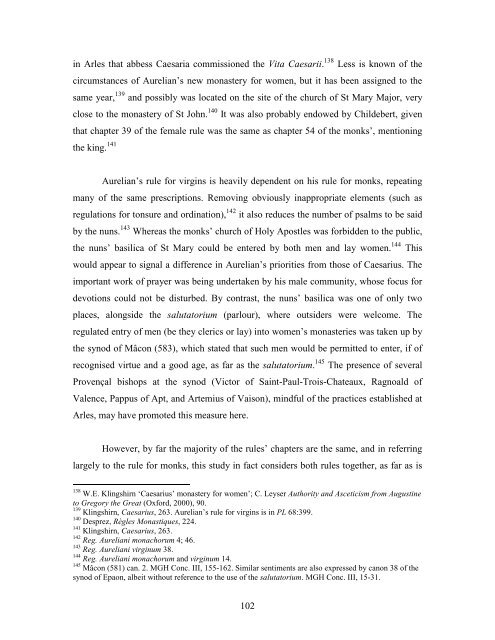Lindsay Rudge PhD Thesis - University of St Andrews
Lindsay Rudge PhD Thesis - University of St Andrews
Lindsay Rudge PhD Thesis - University of St Andrews
Create successful ePaper yourself
Turn your PDF publications into a flip-book with our unique Google optimized e-Paper software.
in Arles that abbess Caesaria commissioned the Vita Caesarii. 138 Less is known <strong>of</strong> the<br />
circumstances <strong>of</strong> Aurelian’s new monastery for women, but it has been assigned to the<br />
same year, 139 and possibly was located on the site <strong>of</strong> the church <strong>of</strong> <strong>St</strong> Mary Major, very<br />
close to the monastery <strong>of</strong> <strong>St</strong> John. 140 It was also probably endowed by Childebert, given<br />
that chapter 39 <strong>of</strong> the female rule was the same as chapter 54 <strong>of</strong> the monks’, mentioning<br />
the king. 141<br />
Aurelian’s rule for virgins is heavily dependent on his rule for monks, repeating<br />
many <strong>of</strong> the same prescriptions. Removing obviously inappropriate elements (such as<br />
regulations for tonsure and ordination), 142 it also reduces the number <strong>of</strong> psalms to be said<br />
by the nuns. 143 Whereas the monks’ church <strong>of</strong> Holy Apostles was forbidden to the public,<br />
the nuns’ basilica <strong>of</strong> <strong>St</strong> Mary could be entered by both men and lay women. 144 This<br />
would appear to signal a difference in Aurelian’s priorities from those <strong>of</strong> Caesarius. The<br />
important work <strong>of</strong> prayer was being undertaken by his male community, whose focus for<br />
devotions could not be disturbed. By contrast, the nuns’ basilica was one <strong>of</strong> only two<br />
places, alongside the salutatorium (parlour), where outsiders were welcome. The<br />
regulated entry <strong>of</strong> men (be they clerics or lay) into women’s monasteries was taken up by<br />
the synod <strong>of</strong> Mâcon (583), which stated that such men would be permitted to enter, if <strong>of</strong><br />
recognised virtue and a good age, as far as the salutatorium. 145 The presence <strong>of</strong> several<br />
Provençal bishops at the synod (Victor <strong>of</strong> Saint-Paul-Trois-Chateaux, Ragnoald <strong>of</strong><br />
Valence, Pappus <strong>of</strong> Apt, and Artemius <strong>of</strong> Vaison), mindful <strong>of</strong> the practices established at<br />
Arles, may have promoted this measure here.<br />
However, by far the majority <strong>of</strong> the rules’ chapters are the same, and in referring<br />
largely to the rule for monks, this study in fact considers both rules together, as far as is<br />
138<br />
W.E. Klingshirn ‘Caesarius’ monastery for women’; C. Leyser Authority and Asceticism from Augustine<br />
to Gregory the Great (Oxford, 2000), 90.<br />
139<br />
Klingshirn, Caesarius, 263. Aurelian’s rule for virgins is in PL 68:399.<br />
140<br />
Desprez, Règles Monastiques, 224.<br />
141<br />
Klingshirn, Caesarius, 263.<br />
142<br />
Reg. Aureliani monachorum 4; 46.<br />
143<br />
Reg. Aureliani virginum 38.<br />
144<br />
Reg. Aureliani monachorum and virginum 14.<br />
145<br />
Mâcon (581) can. 2. MGH Conc. III, 155-162. Similar sentiments are also expressed by canon 38 <strong>of</strong> the<br />
synod <strong>of</strong> Epaon, albeit without reference to the use <strong>of</strong> the salutatorium. MGH Conc. III, 15-31.<br />
102

















